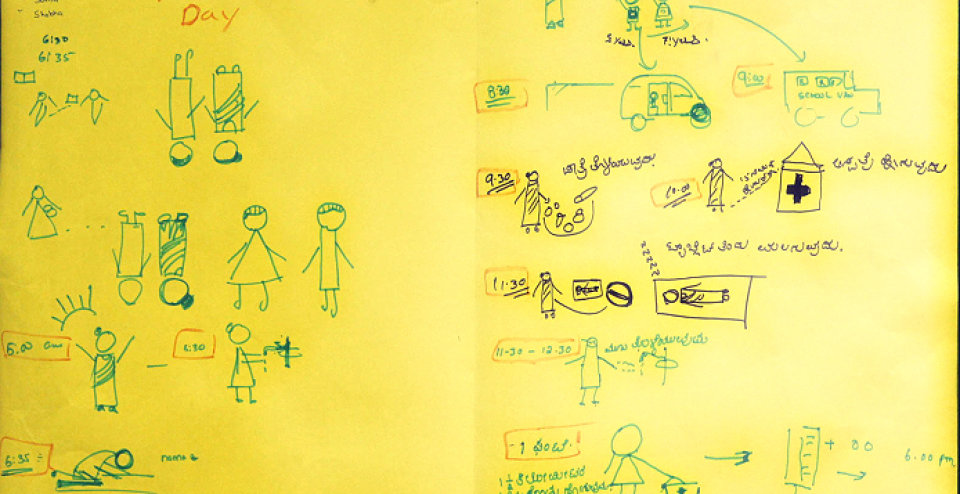
Image sourced from author. Visualisation of daily routines as part of interaction design process in research.
I had the opportunity to co-lead an interaction design team into one of the hamlets in Channapatna, a town near the city of Mysore renowned for its wooden handmade toys. Our design intervention was requested by a Health NGO who over the years had been working with local health counselors in Channapatna. The local health counselors are groups of women trained to provide the community with information about chronic health conditions as well as follow-up on a patient's medical prescriptions and overall progress. Our visit to Channapatna was at a time when the NGO had decided to embark on a new mission of distributing digital Tablet PCs to the health counselors with the idea that portable computing technology would enhance their workflow.
However, rather than following a top-down process of designing a software interface for incorporating various aspects of the health counselor's workflow, our design decisions were based on a bottom-up process where the patients along with health counselors co-created aspects of the technological interface by engaging in multiple creative interventions. The exploration was deeply situated in the actual contexts of the health counselors as well as the homes of the patients.
Our visit to Channapatna was at a time when the NGO had decided to embark on a new mission of distributing digital Tablet PCs to the health counselors with the idea that portable computing technology would enhance their workflow.
Borrowing and evolving methods from participatory design, our intervention proceeded gradually. The first step aimed at building a sense of genuine trust amongst community members and the design team. Some of the exercises included visual representations of their routines, so we could understand how this economic activity fits into their everyday life, their families and aspirations.

Image sourced from author. Visual representations of daily routines.
Diving into methodology
From these activities we started recognising a lot of aspects of the counseling activity that would not be covered in a verbal interview. For instance, visual tools helped us to recognise the multiplicity of the roles that these women perform and their aspirations for strengthening the counseling as a micro entrepreneurial activity. Interestingly, engaging with visual thinking is a powerful tool for understanding metaphors that the community uses and meanings associated with them. Visuals are also mediators to collectively recognise and identify various power dynamics that exist at home, within the community and in public spaces, that indirectly affect the work of counselors. The dynamic throughout the project evolved towards the creation of templates for each activity and leaving them with counselors so they could replicate them with patients.
Visuals are also mediators to collectively recognise and identify various power dynamics that exist at home, within the community and in public spaces, that indirectly affect the work of counselors.
After the preliminary exercises, we moved into identifying opportunity areas for intervention. This is an interesting phase of articulation where we collectively built scenarios for recognising interactions among stakeholders, objects and places where the counselors worked. The opportunities were not framed directly as scenarios where technology could play a role, but as aspects of current experiences of people that needed to be transformed. Some activities included the creation of templates for counselors to craft storyboards of a regular counseling session, emphasising certain aspects of the experience where they lacked the thinking and logistical tools needed to express themselves or to gain credibility by the patients. We also engaged in a lot of enactment and theatrical expression for getting to know how the counseling sessions with different profiles of clients are carried out. We allowed the audience to interrupt the enactment every time they could recognise an opportunity for intervention.
One of the opportunities that we identified was that the patients found it difficult to make decisions about their eating habits, given the very little spectrum of economic choices they had coupled with a lack of knowledge about regular diets and their long term effects. As a result, their medical conditions worsened. At the same time, the counselors lacked tools to help the patients with durable advice, beyond sporadic recommendations. We also visited several houses of patients and explored with them through story-boarding, the different instances where they need greater guidance related to their medical condition.
Having this opportunity area defined, we moved onto the ideation stage using magic as a concept for engaging in a session of expansionary thinking. We crafted a bunch of metaphorical tools like the magic wand or the crystal ball and motivated the counselors to come up with multiple ways to contribute to the situation of diet planning for patients. It took us a couple of rounds to reach a stage where the counselors were comfortable contributing ideas, without restricting themselves to their current understanding of the use of technology. This technique allowed the creation of a space that encouraged expansionary thinking, giving the women counselors more agency during the research process.
It took us a couple of rounds to reach a stage where the counselors were comfortable contributing ideas, without restricting themselves to their current understanding of the use of technology. This technique allowed the creation of a space that encouraged expansionary thinking, giving the women counselors more agency during the research process.


Images sourced from author. Thinking through technology design with theatre and magic.
Another ideation tool was the crafting of low cost prototypes and the enactment of scenarios to incorporate them. Engaging people in the process of finding social scenarios to use a technology helps in overcoming utilitarian views of digital devices. One of the mock-ups that inspired the development of a digital interface was a diet chart made by a group of counselors using low cost materials. This helped to organize information about the nutritional characteristics associated with different ailments. As shown in the picture below, there is a very interesting narrative associated with the diet chart that underlines oral storytelling, family values and well being as larger goals.
Engaging people in the process of finding social scenarios to use a technology helps in overcoming utilitarian views of digital devices.

Image sourced from author. Diet charts being made for input into technology application on tablet PCs.
We used this canvas as a prototype for trying out different variations of presenting information, and conducted several rounds of testing and validation by taking the idea to the houses of some patients and creating a personalized diet plan for them on the site. The diet chart is currently being developed as an application for tablet PCs provided to the counselors by the NGO.
The diet chart is currently being developed as an application for tablet PCs provided to the counselors by the NGO.
Creative research methods facilitate the exploration of larger complexities in a context where there is an intention to employ Information and Communication Technologies (ICTs). Incorporating creative tools also helps in understanding different power imbalances that can prevent or support one to use digital devices and appropriate them without fear. While the design workshops were spaces for imagining uses and appropriations of these devices, the health counselors were part of a parallel digital literacy program where they gained skills to use tablets PCs. An important takeaway was in the counselors realizing that they had agency for not only using digital tools but also guiding and contributing to the design of these tools.

Image sourced from Maya Health
While the design workshops were spaces for imagining uses and appropriations of these devices, the health counselors were part of a parallel digital literacy program where they gained skills to use tablets PCs. An important takeaway was in the counselors realizing that they had agency for not only using digital tools but also guiding and contributing to the design of these tools.
What this means for research?
The nature of this design process contrasted dominant ways of looking at research into the use of ICTs that many times get trapped into quantitative indicators - e.g. number of users or access to physical infrastructure. Instead the design process drove the research towards understanding technology as an experience. The idea here was not to directly design a software application, but to explore the context of use of technology and how the access to information can help overcoming existing barriers for the empowerment of a particular community.
It is important to allow people to inquire into their own realities by making choices about the research process and extend the use of creativity beyond the specification of an end product or an utilitarian solution. Creativity is crucial for engaging with users and understanding their practices, while blurring the lines of distinction between the "researcher" and the "researched".
Creativity is crucial for engaging with users and understanding their practices, while blurring the lines of distinction between the "researcher" and the "researched".
One key aspect of creative processes is the continuous engagement with the materiality of the process as a key component for facilitating the communication between all participants of a research. This collective processes of meaning making, results in the articulation of deep insights that do not come from the mere analysis by researchers and experts only. The key tools within ‘Human Centered Design’ and ´Participatory Design´ methodologies are templates for deconstructing images, conversations and local practices. The templates help to iteratively combine and organize different phases of research, breaking the linearity of traditional design research phases, namely, observation, analysis, ideation, prototyping and documentation.
Despite being capable of providing valuable insights, creative design practitioners have a lot to learn from the social and computer sciences in order to deepen their understanding of the interplay between technology and society. At the same time, social scientists and technologists who usually embrace creativity as an add-on to their final reports in terms of graphic design, should incorporate the same visual tools from the very beginning of their research process. The intersection between disciplines is urgent, and so is the need for directly linking research methods with political action, aiming towards changing realities rather than just understanding them.
The intersection between disciplines is urgent, and so is the need for directly linking research methods with political action, aiming towards changing realities rather than just understanding them.
- 5116 views






Add new comment